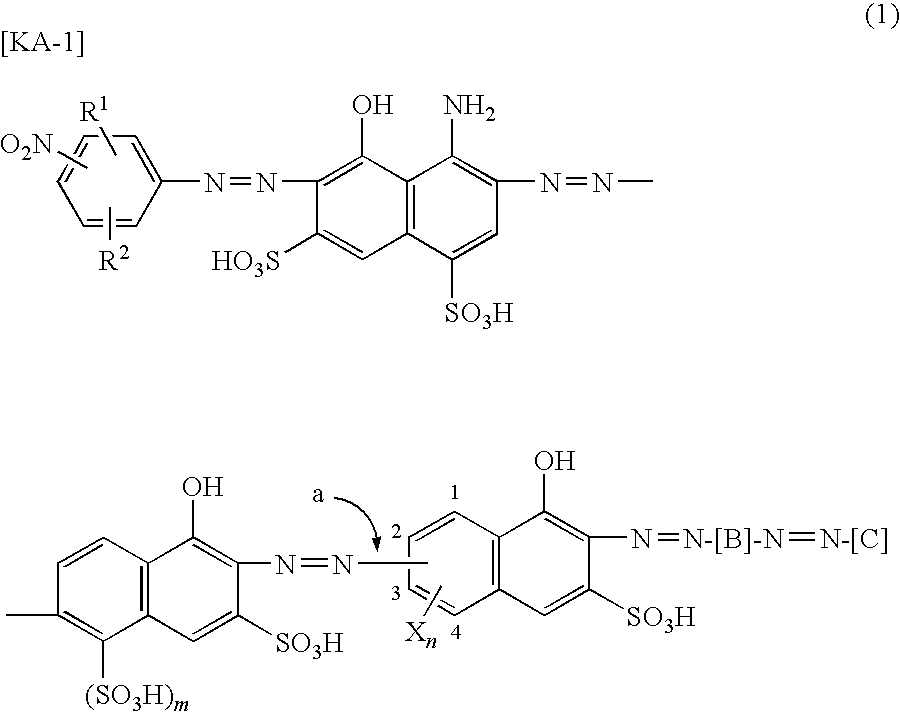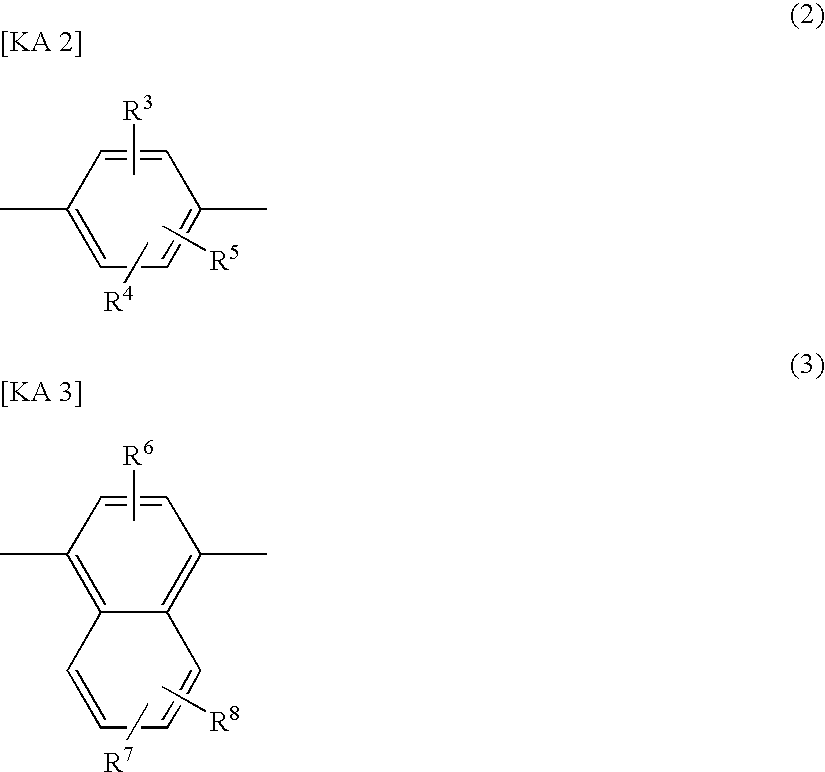Azo compound, ink composition, recording method and colored article
a technology of ink composition and compound, which is applied in the field of azo compound, ink composition, recording method and colored article, can solve the problems of product fully meeting the requirements of the marketplace, low optical density of printed images, and inability to provide products, etc., to achieve excellent water-solubility, good storage stability, and excellent stability
- Summary
- Abstract
- Description
- Claims
- Application Information
AI Technical Summary
Benefits of technology
Problems solved by technology
Method used
Image
Examples
example 1
[0078](1) After 6.4 parts of 2-amino-5-naphthol-1,7-disulfonic acid and 4.1 parts of p-toluenesulfonyl chloride were reacted at pH 8.0 to 8.5 at 70° C. for 1 hour, the reaction product was subjected to salting out by addition of a sodium chloride under acidic conditions and filtration-separated to obtain a compound of the formula (18), 8.8 parts of which compound was dissolved in 90 parts of water while adjusting the pH at 6.0 to 8.0 with sodium carbonate, followed by addition of 6.8 parts of 35% hydrochloric acid, and then, with the temperature adjusted at 0 to 5° C., 3.6 parts of a 40% sodium nitrite aqueous solution was added thereto for diazotization.
[0079]To this diazo suspension, a liquid where 5.8 parts of 4-amino-5-hydroxynaphthalene-1,7-disulfonic acid was suspended in 60 parts of water was added, followed by stirring for 4 hours while maintaining the pH value of the solution at 2.4 to 2.8 with sodium carbonate at 10 to 20° C. Subsequently, the reaction product was dissolve...
example 2
[0085]In the same manner as in Example 1 except that 5.2 parts of sodium 2-nitroaniline-4-sulfonic acid was used instead of 5.2 parts of sodium 4-nitroaniline-2-sulfonic acid in (2) of Example 1, 17.0 parts of an azo compound of the formula (26) of the present invention (a compound No. 2 in Table 2) was obtained as a mixed salt of lithium and sodium. The maximum absorption wavelength (λ max) of this compound in an aqueous solution of pH 9 was 571 nm and the solubility was not less than 100 g / L.
example 3
[0086]Instead of 5.3 parts of the compound of the formula (24) in (4) of Example 1, 10.8 parts of a compound of the following formula (27) obtained in the method described in JP 2005-068416 was used, which compound was dissolved by adjusting the pH to 6.0 to 7.0 with a sodium hydroxide, and 4.9 parts of 35% hydrochloric acid and 2.7 parts of a 40% sodium nitrite aqueous solution were added thereto at 0 to 5° C. for diazotization. This diazo suspension was added dropwise in a solution where a wet cake containing a compound of the formula (23) obtained in the same manner as in Example 1 was dissolved in 260 parts of water, at 15 to 30° C. while maintaining the pH of the solution at 8.0 to 9.0 with soda ash. After completion of the dropwise addition, it was stirred at 15 to 30° C. for 2 hours at pH 8.0 to 9.0 and heated to 70° C., and then further stirred for 1.5 hours while maintaining the pH value at 10.5 to 11.0 with a sodium hydroxide.
[0087]After cooling it to room temperature, the...
PUM
| Property | Measurement | Unit |
|---|---|---|
| Solubility (mass) | aaaaa | aaaaa |
| Transmission | aaaaa | aaaaa |
| Storage stability | aaaaa | aaaaa |
Abstract
Description
Claims
Application Information
 Login to View More
Login to View More - R&D
- Intellectual Property
- Life Sciences
- Materials
- Tech Scout
- Unparalleled Data Quality
- Higher Quality Content
- 60% Fewer Hallucinations
Browse by: Latest US Patents, China's latest patents, Technical Efficacy Thesaurus, Application Domain, Technology Topic, Popular Technical Reports.
© 2025 PatSnap. All rights reserved.Legal|Privacy policy|Modern Slavery Act Transparency Statement|Sitemap|About US| Contact US: help@patsnap.com



